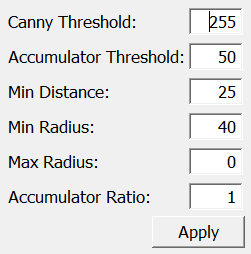cvHoughCircles¶
-
MLModule¶ author MeVis Medical Solutions AGpackage MeVisLab/Standarddll MLOpenCVModulesdefinition MLOpenCVModules.def
Purpose¶
The cvHoughCircles offers the OpenCV 2D HoughCircles algorithm. It detects circles on
each 2D slice of the given volume and generates markers with the detected circle centers and
radius. The radius is stored in the direction component of the vector, orthogonal to the 2D slice.
The markers are stored in world coordinates. A good way to visualize the markers is to use a SoView2DMarkerEditor with drawMode “Disc”, as shown in the example module.
Internally the module only supports the MLuint8 datatype, all input data is rescaled to the range 0-255.
Output Fields¶
outCircles¶
-
name:outCircles, type:XMarkerList(MLBase)¶ - For accessing this object via scripting see the Scripting Reference:
MLXMarkerListWrapper.
Parameter Fields¶
Field Index¶
Accumulator Ratio: Double |
Accumulator Threshold: Double |
Apply: Trigger |
Canny Threshold: Double |
Max Radius: Integer |
Min Distance: Double |
Min Radius: Integer |
Visible Fields¶
Min Distance¶
-
name:minDistance, type:Double, default:10¶ The minimum distance between detected circle centers.
Max Radius¶
-
name:maxRadius, type:Integer, default:0¶ The maximum radius of detected circles. 0 means the maximum radius is not limited.
Canny Threshold¶
-
name:cannyThreshold, type:Double, default:100¶ The threshold for the canny edge detection (in rescaled 8bit range).
Accumulator Ratio¶
-
name:accumulatorRatio, type:Double, default:1¶ The resolution of the accumulator (0.5 means the accumulator has half the resolution of the image)
